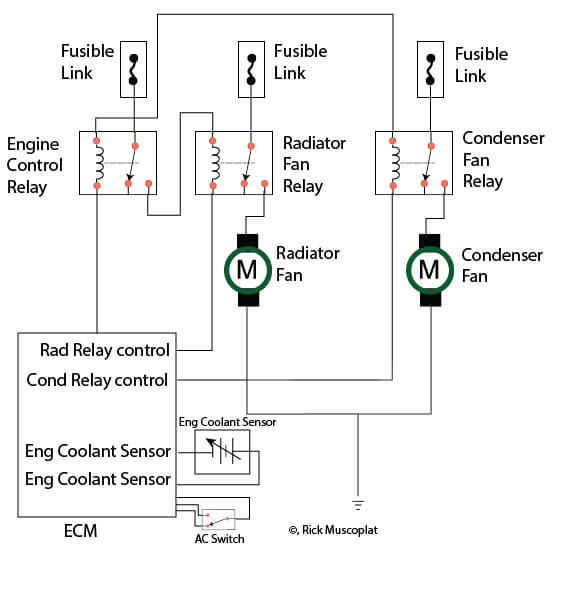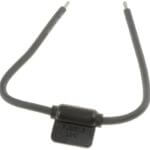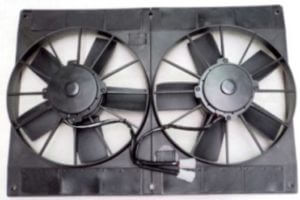Hyundai Wiring Diagram Radiator Fans
Hyundai wiring diagram for radiator cooling fans
This is a typical Hyundai wiring diagram for the radiator fan and AC condenser fan. The system uses a radiator fan relay and a condenser fan relay. Both receive power from fusible links, not ordinary fuses.

How Hyundai radiator fans work
The control coil for the radiator fan relay and condenser fan relay receive power from the engine control relay that is activated when you start the vehicle. The ECM monitors engine temperature through the engine coolant temp sensor. When it senses that engine coolant temp has reached a point where it needs cooling, the ECM provides ground to the radiator fan relay control coil. The relay activates and provides power to the radiator fan.
The AC condenser fan relay is activated by the ECM when the AC switch is turned on. The ECM then provides ground to the control coil on the condenser fan relay. The condenser fan relay provides power to the condenser fan. Both fans ground receive ground at G109 located on the right radiator support.
Hyundai overheats
If the radiator fan relay is activated and the ECM detects that the fan can’t provide adequate cooling, it will activate the condenser fan relay to provide supplemental cooling. If both fan can’t provide enough cooling and the temperature gauge rises into the danger zone, stop driving the vehicle and have it towed to a shop. Continuing to drive while the engine is overheated can warp the cylinder head and damage the head gasket, costing at least $1,500 in repairs.
Check fan operation first
If the gauge indicates an overheating condition and both fans are running
Check for plugged fins on the condenser and radiator
Check coolant level
Check water pump operation
Check for a damaged head gasket
Troubleshoot Hyundai overheating condition caused by fans
Check the fusible links
Remove the Engine control relay, radiator fan relay

Fusible link
and condenser fan relays and check for battery voltage. The relays are located in the engine compartment relay/fuse box. Check for battery power in the relay sockets on these terminals. These pins should have power at all times, even with the key out of the ignition.
Engine control relay: pins 2 & 5
Radiator fan relay: pin 1
Condenser fan relay: pin 2
If you find power at all those points, that confirms the fusible links are good.
Check for relay control power
Next, turn the key to the RUN position and check for battery voltage on these pins:
Radiator fan relay: pin 5
Condenser fan relay: pin 5
If you see battery voltage, that confirms the engine control relay is providing power to the control coil side of the relays.
Check for condenser fan control coil ground
With the key in RUN position, turn the AC ON. Then check for ground on pin 1 in the condenser fan relay socket. If you detect good ground, the ECM is operating properly
Check radiator fan operation
If you’ve confirmed the fusible links are good  proceed by placing the relays back in their sockets, run the engine at idle and wait for the radiator fan to activate while watching the temperature gauge. If the gauge rises into the danger zone but the radiator fan doesn’t activate, remove the radiator fan relay and check for ground on pin 3. If you don’t get ground on pin 3, the ECM is not activating the radiator relay. That can be caused by a faulty engine coolant temperature sensor or a wiring problem between the ECM and pin 3.
proceed by placing the relays back in their sockets, run the engine at idle and wait for the radiator fan to activate while watching the temperature gauge. If the gauge rises into the danger zone but the radiator fan doesn’t activate, remove the radiator fan relay and check for ground on pin 3. If you don’t get ground on pin 3, the ECM is not activating the radiator relay. That can be caused by a faulty engine coolant temperature sensor or a wiring problem between the ECM and pin 3.
If you do find ground on pin 3, jumper across pins 1 & 2 in the socket. If the radiator fan runs, then the radiator fan relay is bad. Replace it.
If the fan still doesn’t run, provide battery power and ground directly to the fan. If it doesn’t run, the radiator fan is bad
Check condenser fan relay operation
If you’ve already confirmed that the condenser fan relay fusible link is good and is receiving control coil ground from the ECM when the AC is turned on, but the condenser fan doesn’t run, jumper across pins 1 & 2 in the condenser fan relay socket. If the condenser fan runs, the relay is bad. Replace it.
If the condenser fan doesn’t run, provide battery power and ground directly to the fan. If it doesn’t run, the condenser fan is bad.
If both fans run but the engine overheats
©, 2017 Rick Muscoplat
Posted on by Rick Muscoplat